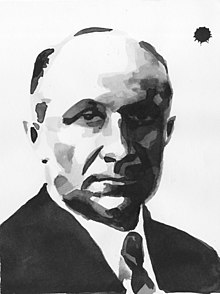Jüri Parijõgi
Jüri Parijõgi (to 1935 Jüri Parinbak or Pari Bach , born August 21, jul. / 2. September 1892 greg. In Siberi, today rural community of Viru-Nigula ; † 9. July 1941 in Tallinn ) was an Estonian teacher and youth book author.
Life
Jüri Parijõgi attended the town school of Rakvere from 1905 to 1908 , where he also took courses in pedagogy in 1910. From 1910 to 1915 he was a teacher at a school near Rakvere before he was drafted into the Imperial Russian Army as a soldier in World War I. After the end of the war he worked briefly as a teacher again, but soon took part in the Estonian War of Independence (1919–1920). After that he was again a teacher in Rakvere and head of the teachers' college there until 1929.
In 1929 he went to Tartu , where he passed the Abitur as an external student. From 1930 he was director of an elementary school in Tartu and attended lectures at the University of Tartu until 1931 . After the Soviet annexation in June 1940, Nigol Andresen appointed him acting director of the teachers' college at the University of Tartu in September of the same year, without his knowledge and against his will. After the expansion of the Second World War to Estonia, Parijõgi was called in for fortification work in Tartu in July 1941 and picked up by the NKVD on the night of July 8th . The next night he was shot together with 192 other prisoners in the mass murder in Tartu prison (1941) .
plant
Today, Jüri Parijõgi is considered a classic of Estonian children's and youth literature, who "created its own tradition" and whose debut The Cement Factory "stands out against the background of all of Estonian children's literature." The reason for this is the consistently realistic style of the author, who soberly describes the world around him with the eyes of a seven or eight year old boy. As a result, his prose can initially be thematically compared with the work by August Jakobson, which appeared around the same time , but since the author later devoted himself exclusively to children's and youth literature, he is generally assigned to this category.
In addition to his realistic stories from the life of growing boys, Parijõgi also wrote travel books, Christmas stories and fairy tales. He also made an active effort to promote children's and youth literature and was the author of numerous school books. Stage versions of some texts were created. His books have been translated into Finnish, Polish, Russian and German.
In the German-speaking countries he is only represented with a fairy tale collection, but some of his fairy tales also appear in general Estonian fairy tale collections:
- The guest bread and other Estonian fairy tales . Translation from Estonian by Haide Roodvee and Helga Viira. Illustrations by Silvi Väljal . Tallinn: Eesti Raamat 1984. 94 pp.
There is also a Christmas story in German:
- Christmas at home. Translated by Benita Eisenschmidt, in: Baltica 4/1992, pp. 44-48.
Besides Friedrich Reinhold Kreutzwald , Oskar Luts , Eno Raud and Irma Truupõld, Parijõgi also got an entry in Metzler's classics of children's and youth literature .
bibliography
-
Semendivabrik ('The Cement Factory '). Tartu: Loodus 1926. 121 pp.
- Translated into Russian
-
Laevapoisi päevilt ('From the days of a cabin boy'). Tallinn: Eesti Õpetajate Liit 1927. 126 pp.
- Translated into Finnish and Russian
- Ühe poisu reisilood ('travel stories of a boy'). Tallinn: Pääsuke 1927. 32 pp.
- Kevad kutsub ('Spring is calling', travel memories from Muhu and Saaremaa ). Tallinn: Eesti Õpetajate Liit 1929. 80 pp.
- Soome ('Finland', travel book). Tallinn: Eesti Õpetajate Liit 1929. 70 pp.
- Jaksuküla poisid ('The boys from Jaksuküla'). Tartu: Loodus 1930. 118 pp.
- Jõulud! Jõulud! ('Christmas! Christmas!'). Tallinn: Eesti Õpetajate Liit 1930. 63 pp.
- Suuskadel Vallastesse ('On Skis to Vallaste'). Tallinn: Eesti Õpetajate Liit 1932. 80 pp.
-
Külaliste leib ja teisi eesti muinasjutte . Tartu: Eesti kirjanduse Selts 1933. 135 pp.
- Translated into Finnish, Russian and German (see above)
- Kaks reisu ('Two journeys'). Tartu: Loodus 1936. 155 pp.
- Meie Eku ('Our Eku'). Tartu: Kool 1937. 168 pp.
-
Teraspoiss ('steel boy'). Tartu: Loodus 1937. 207 pp.
- Translated into Polish
- Kulbult Atlandile ('From Kulbu to the Atlantic') Tartu, Tallinn: Loodus 1939. 176 pp.
- Alutaguse metsades ('In the woods of Alutaguse', travel memories). Tartu: Loodus 1937. 239 pp.
Literature on the author
- Reet crusts: Jüri Parijõe elu ja loomingu teedel, in: Keel ja Kirjandus 5/1960, pp. 281–294; 6/1960, pp. 327-339.
- Maie Kalda: "Semendivabrik" ei olnud lastekirjandus, in: Looming 9/1992, pp. 1269-1272.
- Reet crusts: Jüri Parijõe viimane aasta, in: Keel ja Kirjandus 9/1992, pp. 513-518.
Individual evidence
- ↑ Reet crusts Jüri Parijõe viimane aasta, in: Keel yes Kirjandus 9/1992, S. 514th
- ↑ Eesti kirjanike leksikon. Koostanud Oskar Kruus yes Heino Puhvel. Tallinn: Eesti Raamat 2000, pp. 396-397.
- ↑ Reet crusts: Eesti Lastekirjandus. Tartu : Elmatar 1995, pp. 145-146.
- ↑ Cornelius Hasselblatt : History of Estonian Literature. From the beginning to the present. Berlin, New York: Walter de Gruyter 2006, p. 496.
- ↑ Cf. Cornelius Hasselblatt: Estonian literature in German translation. A reception story from the 19th to the 21st century. Wiesbaden: Harrassowitz 2011, pp. 284–286.
- ^ Bettina Kümmerling-Meibauer: Classics of children's and youth literature. An international lexicon. Stuttgart, Weimar: Metzler 1999. Volume 2, pp. 831-832.
| personal data | |
|---|---|
| SURNAME | Parijõgi, Jüri |
| ALTERNATIVE NAMES | Parinbak, Jüri; Parinbach, Jüri |
| BRIEF DESCRIPTION | Estonian educator and author of books for young people |
| DATE OF BIRTH | September 2, 1892 |
| PLACE OF BIRTH | Siberi, Viru-Nigula rural municipality |
| DATE OF DEATH | July 9, 1941 |
| Place of death | Tartu |
